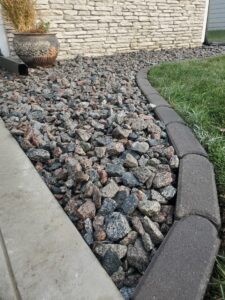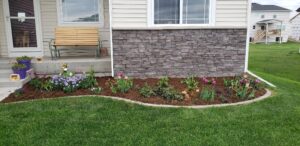When designing a landscape, it’s important to pick a ground cover option that fits the space and the needs of the homeowner. Some groundcovers will last a long time with very little maintenance. Other options will need to be maintained annually for optimum performance. The most common landscape options are either rock or mulch. There are a wide variety of options of each available in the Midwest market. Rock is generally considered to be a low maintenance option while mulch is a higher maintenance option.
When using rock, it is essential to pick a landscape fabric that will last a long time. This is the most crucial step in creating low maintenance landscapes. The fabric will act as a barrier between the soil and the rock to prevent weeds from growing through the rocks. If a cheaper landscape fabric is used, it can break down and still allow weeds to grow. Many of the big box stores sell fabric that range from five to twenty-year fabric. Generally, the longer the fabric lasts, the thicker it is going to be.
Landscape Fabric: Non-woven or Woven?
Non-woven landscape fabric is usually composed of polypropylene or polyester fibers. This is like normal cotton fabric in terms of density and texture. Non-woven fabric is the least desirable fabric to use in landscape beds under rock. Due to the density and the texture, non-woven fabric will not allow water to filter through the fabric as easily as other fabric options. Non-woven fabric is best suited for underlayment on patios and walkways or behind concrete block or boulder retaining walls. Woven landscape fabric is composed of polypropylene fibers that are intertwined with each other like how a tarp is created. Because the fabrics are tightly woven, weeds generally cannot grow through the weaving. However, water and nutrients can still filter through the fabric.
When placing landscape fabric, it is best to place directly on the soil. Remove any sod or previous ground cover before placing the fabric on the soil. When covering the landscape fabric, make sure to use a minimum of at least three inches of rock. You do not want to be able to see any pieces of the fabric through the rock. This will limit the amount of UV damage the sun causes on the fabric. UV light can cause the fabric to break down quicker. When using landscape fabric, do not place mulch on top of the fabric. Since mulch is an organic material, it will break down over time creating a layer of compost on top of the fabric. This will allow a place for weed seeds to germinate.
Iowa River Rock and Other Rock Options
 The most common types of rock used in Iowa is river rock. River rock is a waste product from sand pits and is a smooth type of rock. It is found in rivers and streams and has been eroded into small pieces over time due to glacier movement thousands of years ago and eroding in the flowing waters.
The most common types of rock used in Iowa is river rock. River rock is a waste product from sand pits and is a smooth type of rock. It is found in rivers and streams and has been eroded into small pieces over time due to glacier movement thousands of years ago and eroding in the flowing waters.
River rock has brown tones to it but can also have black, red, blue, and green rocks mixed in. It comes in multiple sizes from pea gravel (3/8 inch), one inch, two-inch, three inch, and 4–8-inch river cobble.
Pea gravel is best used for walkways while two-inch river rock is best suited for landscape beds. The two-inch river rock is heavy enough that when doing fall cleanup, leaf blowers can remove the leaves, but the rocks will stay put. The 4–8-inch cobble is best suited for landscape borders, dry steam beds, and koi ponds.
Another common type of landscape rock used in Iowa is trap rock. Trapp rock is a blue-gray color and has a jagged, pointy texture compared to the smoothness of the river rock. In Iowa, most trap rock is shipped in from quarries in Wisconsin. The blue-gray color of trap rock will give landscapes a very modern look. Pairing trap rock with Iowa Buff stone or Chilton stone provides an excellent dark and light contrast in the landscape. Trap rock comes in a 3/8 chip used for pathways as well as 1-2 inch best suited for landscape applications.
Buckskin rock is also widely available in central Iowa as a landscape ground cover option. This style of rock comes in an orange/tan/peach type color and is similar in texture to trap rock. Buckskin is mined in the western united states and shipped to Iowa. Because of its unique color, buckskin rock can be used to compliment pool landscapes providing a desert southwest landscape theme. Buckskin also comes in 3/8 which is great for pathways as well as ¾ and 1 ½ inch which is best suited for landscape bed applications.
A less popular but beautiful landscape rock option in central Iowa is purple quartz. This is a pinkish/purple rock mined in southern Minnesota and shipped to central Iowa. This is a subtle color of rock but would be a unique option for those wanting a landscape item rarely used in central Iowa. Purple quartz is similar in texture to trap rock and comes in a 1 ½ size. A very similar product, speckled granite comes in ¾ inch as well as 2/ ½ inch sizes. A variety of additional colors include pink quartz, pink granite, red quartz, and red granite.
Many customers ask us what the advantages and disadvantages of rock are. If someone is looking for a landscape that is low maintenance, rock is generally the route to go. For those who enjoy gardening and like to spend time in their landscaping, mulch might be the better option. For customers who like to plant annuals each year such as petunia, marigold, sunpatiens, begonia, and snapdragons, mulch is the route to go. Any time you cut a hole in the landscape fabric; you are creating an avenue for weed growth.
Types of Mulch Available in Iowa

Cypress mulch is a low-cost mulch and does break down quicker than other forms of mulch. We generally try to avoid cypress mulch in our landscape projects.
Cedar mulch is our preferred mulch that we use in our landscapes. Cedar mulch is the slowest mulch to degrade and has a wonderful aroma. Pest such as termites generally stay away from cedar mulch making it a great choice for houses in wooded areas and for foundation plantings.
Cypress mulch and cedar mulch are usually shipped to the Midwest from varying areas of the United States.
Hardwood mulch however is generally processed in the Midwest from hardwood trees such as oak and hickory. Hardwood mulch can come in both dyed and un-dyed colors. Non-dyed hardwood mulch is a brown wood color and tends to fade to gray quickly. Dyed mulch comes in colors such as brown, red, gold, and black. As the mulch is being shredded and processed from the logs, it is coated in a non-toxic paint like substance which gives the mulch its color.
A common misconception with mulch is that mulch allows weeds to grow. However, if done correctly, mulch is just as good as rock at preventing weed growth.
The two biggest factors for preventing weeds in mulch beds is the mulch depth and the flower bed preparation before mulch is applied. No matter the kind of mulch used, a minimum of 3-4 inches of mulch should be applied to new landscapes or landscapes that are bare soil. When mulching flower beds, it is also critical to make sure that all the weeds and sod are removed before mulch is placed.
We do not recommend using landscape fabric with mulch. Since mulch is an organic material, it will break down over time. As the mulch breaks down, it will create a layer of compost on top of the landscape fabric potentially allowing for weeds to grow on top of the landscape fabric.
When trying to choose between rock and mulch, it’s important to look at the environmental conditions of the area where the product is going to be placed. For areas where water stands frequently or where water washes during heavy rainfall, rock is almost always going to be the better option. Mulch can get moldy if it is in a place that is frequently wet. However, if you are landscaping a southern exposure that gets warm from the sun, mulch may be the better option. Rock can act as a reflector and cause the location to get extra warm which can harm plants in the area. Mulch does a better job of absorbing the heat than rock does. If you are going to landscape a southern exposure with rock, choose heat tolerant plants such as daylily and sedum.
Because all types of mulch do break down, adding a new layer of mulch every year is recommended. The new layer only needs to be one inch each year and only acts as a top-dress application. The only exception would be to add more mulch in areas where the mulch has been disturbed or the mulch is not at least three inches deep.
When putting mulch on the soil in new landscapes, pre-emergent herbicides such as Preen, or Snapshot can be applied to the bare soil. On top-dress applications, the pre-emergent can be applied to the top of the mulch can covered with the new layer. Pre-emergent herbicides are usually a granular pellet that when activated with water break down and keep new weeds seeds from growing. Pre-emergent herbicides will not kill existing flowers, plants, or shrubs so it is critical to remove any unwanted plants in the landscape before applying the per-emergent. The pre-emergent will generally last 6-8 weeks before a second application is needed. Wetter locations will need to reapply more frequently to keep weeds from growing.
If your landscape needs to be updated or maintained, contact TeBock’s Landscape. We work with the customer to identify the wants and the needs of each location to ensure that you have the best landscape around.



